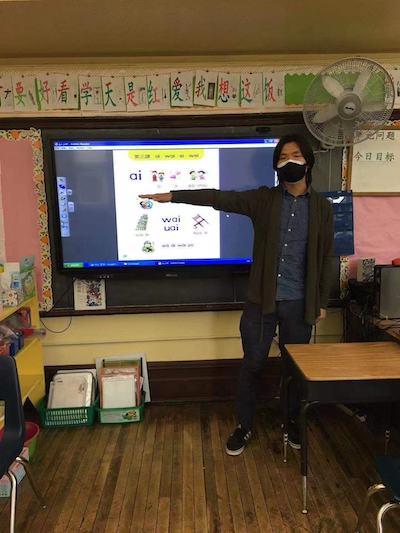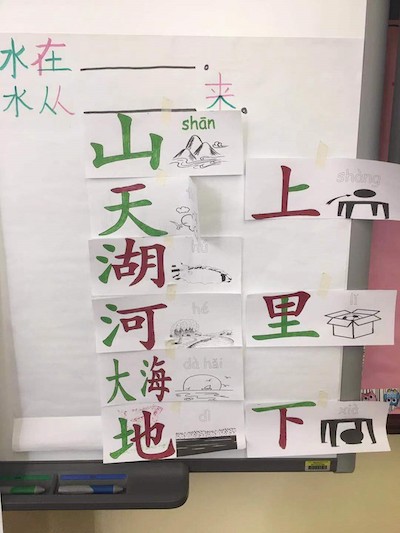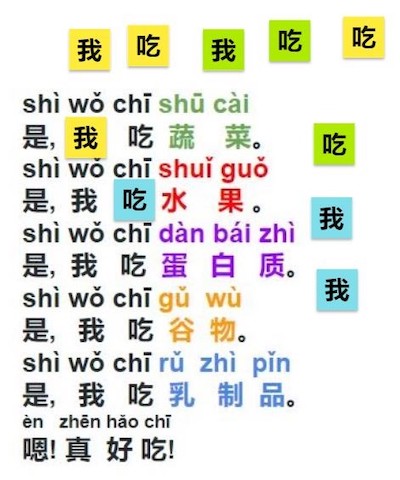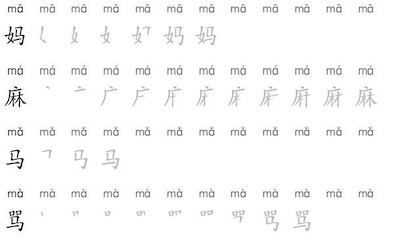|

Manqian Zhao
|
|

Ruomu Wang
|
“同学们,早上好, 从今天开始我们要在语文课上学习拼音。(Good morning boys and girls, today we will start learning Pinyin in our Chinese literacy lesson.)” First-grade Chinese teacher Mr. Li told his class. Mia got very excited, she raises her hand and loudly shares to the whole class in both Chinese and English before her teacher calls her name, “李老师,李老师 (Mr. Li, Mr. Li), 我知道拼音 (I know Pinyin!) My mom had taught me how to read Pinyin when I was young.” Mia’s reaction made her desk mate, Eiden, confused. He whispered to Mia, “What is Pinyin?”
Hanyu Pinyin (also known as Pinyin) is the official Romanized system in mainland China to annotate Mandarin Chinese. It aims to help young students in China pronounce Chinese characters correctly (Asian society, 2006). It uses an alphabetical letter with tone note to be Chinese character's phonetic notation, e.g., 妈 (mom) is noted /mā/. This system is commonly used in mainland China as an aid for word learning. Although Pinyin has been widely used in Mainland China to teach Chinese characters, there are concerns regarding the introduction of a new phoneme system to young bilingual students in dual immersion programs. Bilingual programs focus on helping students develop biliteracy in both languages from a young age, and as such, fully immerse them into a multicultural education environment. With the goal to develop high levels of language proficiency and literacy in both languages (Howard et al., 2007), teaching should consider all the language repertoire and knowledge while learning both languages. This means Pinyin learning should happen in both Chinese and English literacy classrooms to build a complete cross-linguistic awareness for young students. Thus, uncertainty of how to introduce and support bilingual students as well as the Pinyin development of linguistic awareness become a pressing focus for bilingual teachers in the program.
To answer these questions, in the following paragraphs we will follow the successful example of an experienced Chinese teacher, Mr. Li and his partner teacher, Mrs. Wilson, to explore the teaching strategies. They take the biliteracy unit framework (Beeman and Urow, 2013) and offer teaching strategies on English-Mandarin bilinguals with the support of Pinyin in the literacy development domains of building background knowledge, vocabulary, reading, writing, and bridging the two languages.
Background knowledge
Background knowledge is a tool for students to understand a new concept from the classroom and apply it to the world around them. Building background knowledge is connecting existing knowledge with the new concept and simultaneously seals a solid foundation to extend deeper conceptual understanding (Beeman and Urow, 2013). In the stage of building background knowledge, bilingual teachers should consider the variance background knowledge that students bring into the classroom. Just like the two students at the beginning of the story, the girl Mia had already learned Pinyin from home. The boy Eiden had never heard of Pinyin. To fully engage every student, their Chinese teacher, Mr. Li, starts with Total Physical Response (TPR).
TPR was modified by Beeman and Urow (2013) in a bilingual program, in which key vocabulary and concepts are represented by a gesture. In Mr. Li’s classroom, TPR will be applied to indicate the four different tones in Chinese. The four tones are keys to differentiate the meaning of each character. They are: /mā/妈(mom); /má/麻(hemp); /mǎ/马(horse); /mà/骂(scold). However, their meanings can be applied differently. For example, although they all share the same spelling /ma/, different tones lead to an entirely different meaning. Mr. Li writes down a new sound /i/ with all four tones on the board /ī/; /í/; /ĭ/; /ì/. As he pronounces each sound, he uses his arms to demonstrate the tone differences. Afterwards, he asks the students to join him and repeat the actions. The photo below shows a Chinese teacher using TPR to indicate the first tone (flat). When the students get familiar with the connection between the gesture and the tone, Mr. Li moves to another new sound /e/ and repeats the routine. TPR can help students improve their understanding of Chinese tones and quickly apply their differences to develop Chinese learning. TPR is also an activity that builds a solid background knowledge between the tone and the gestures for young students. With the help of TPR, students can quickly identify the differences between the tones, which is very important for learning a tonal language.

Photo caption: Pinyin Tone 1
Vocabulary and Reading
Vocabulary and Reading are key skill sets that lead to the mastery of language proficiency and literacy in both languages. Building vocabulary/character walls have been commonly used in bilingual classrooms. Vocabulary walls can help students review characters they have learned, as well as make connections between characters and Pinyin. The Chinese teacher, Mr. Li, uses character walls as a classroom vocabulary resource. He creates a word card to introduce new words. The word card has the characters, corresponding Pinyin, and a picture that can represent the word. Mr. Li holds the card, introduces the word, and then adds the word to the vocabulary wall. When introducing new sounds in Pinyin, Mr. Li leads students to the vocabulary wall and guides students to find characters that contain the sounds that they have previously learned. In this way, students are simultaneously learning characters and Pinyin. For example, Mr. Li introduces a new sound /sh/, and on the vocabulary wall in the photo below. Students can find the Pinyin /sh/ next to the character “ 山“.

Photo caption: Pinyin Sounds
Pinyin serves as a dual purpose. It is a tool to access the pronunciation of Chinese characters and an important aid for promoting reading fluency in young children. However, relying heavily on Pinyin could inadvertently lessen the impact of learning characters. The character matching activities combined with Pinyin can help students reinforce learning the characters. After a few lessons of vocabulary learning, Mr. Li makes some word cards with characters only and asks the students to take the cards and match the characters on the vocabulary wall. When students find the matched characters on the wall they then need to read them out loud. This activity emphasizes the focus on the stroke differences among characters rather than Pinyin; however, students are able to use Pinyin as an aid to help them pronounce the characters correctly. This activity can be also used in sentences and paragraph reading as shown in the photo below.

Photo caption: Pinyin Paragraph Reading
Writing
Although Pinyin is a Romanized phonetic notation, students still need some training on correctly using the note tone on each syllable. Moreover, English/Mandarin bilinguals need to know how to spell Pinyin but more importantly, how to write the corresponding characters. The matching activity combines learning vocabulary successfully while bringing the student’s attention to both the Roman alphabet and Chinese characters, which provides a great opportunity for teaching students how to write. Mr. Li has two steps to guide students to practice both Pinyin and character writing simultaneously. First, he writes the Pinyin on the board. Then he encourages students to do air writing with him stroke by stroke. After air writing, Mr. Li prepares a writing worksheet with all the new characters, as shown in the photo below. The writing worksheet has Pinyin on top of each character and indicates the sequence of the strokes. Students are asked to trace both Pinyin and strokes on the worksheet and learn how to write.

Photo caption: Character Stroke
Building the Bridge
In order to encourage students to use all language repertoire and develop bilingual awareness, the Biliteracy unit framework (Beeman and Urow, 2013) emphasizes strengthening the bridge between languages. Both English and Mandarin teachers should collaborate to make connections across these two languages while teaching in dual immersion programs. The introduction of Pinyin provides opportunities for students to see the similarities and differences between these two languages. Mr. Li’s partner teacher, Mrs. Wilson, creates a table to make the Pinyin and English phoneme comparisons more visible for the first-grade students, as shown in the photo below. Mrs. Wilson first introduces the sound of the letter in English and prints it on the left column of the table. Then she asks students to think of some words that start with or contain the sound. Next, Mrs. Wilson asks students to be her Chinese “tutors” and teach her the sound of that letter in Pinyin. Next, she prints the letter on the Pinyin side of the column and encourages students to print the full syllable that starts/contains the sounds and print the characters as well. The table becomes a great bridge for students to understand the similarities and differences between these two languages.

Photo caption: Pinyin-English Phoneme Comparison
To help English/Mandarin bilingual teachers have a successful introduction to Pinyin to young students, we followed Mr. Li and Mrs. Wilson’s teaching strategies in the domains of building background knowledge, vocabulary, reading, writing and bridging under the biliteracy unit framework (Beeman and Urow, 2013). We hope students like Mia and Eiden with a variety of language backgrounds will benefit from learning Pinyin with these strategies.
References
Beeman, K., & Urow, C. (2013). Teaching for biliteracy: Strengthening bridges between languages. Philadelphia, PA: Caslon Publishing.
Howard, E. R., Sugarman, J., Christian, D., Lindholm-Leary, K. J., & Rogers, D. (2007). Guiding principles for dual language education. Washington, DC: Center for Applied Linguistics.
Manqian Zhao is a fifth-year doctoral student in Curriculum and Instruction in the Neag School of Education at the University of Connecticut. With language proficiency in Mandarin Chinese, Cantonese Chinese, English, and teaching experience in bilingual programs, Manqian’s research focuses on cross-linguistic transfer among young Mandarin-English bilingual students with the support of Pinyin. Ruomu Wang is a bilingual teacher in St. Michael’s Catholic Academy. He has more than six year teaching experience and holds a master’s degree of education from Hofstra University. |

